Effect of Cr Doping on the Structural, Optical and Dielectric Properties of MoO3 Microrods Synthesized by Sol-Gel Auto Combustion Method
Abstract
:1. Introduction
2. Experimental Method
3. Results and Discussion
3.1. Phase Analysis
3.2. Surface Morphology
3.3. Diffuse Reflectance Spectroscopy
3.4. Optical Properties
3.5. Dielectric Properties
4. Conclusions
Author Contributions
Funding
Data Availability Statement
Acknowledgments
Conflicts of Interest
References
- Doss, V.A.; Chithambararaj, A.; Bose, A.C. Effect of reaction atmosphere on structural and optical properties of hexagonal molybdenum oxide (h-MoO3). AIP Conf. Proc. 2016, 1731, 050049. [Google Scholar]
- Hu, H.; Deng, C.; Xu, J.; Zhang, K.; Sun, M. Metastable h-MoO3 and stable α-MoO3 microstructures: Controllable synthesis, growth mechanism and their enhanced photocatalytic activity. J. Exp. Nano. 2015, 10, 1336–1346. [Google Scholar] [CrossRef]
- Wongkrua, P.; Thongtem, T.; Thongtem, S. Synthesis of h-and α-MoO3 by refluxing and calcination combination: Phase and morphology transformation, photocatalysis, and photosensitization. J. Nano Mater. 2013, 2013, 79. [Google Scholar]
- Brezesinski, T.; Wang, J.; Tolbert, S.H.; Dunn, B. Ordered mesoporous α-MoO3 with iso-oriented nanocrystalline walls for thin-film pseudocapacitors. Nat. Mater. 2010, 9, 146–151. [Google Scholar] [CrossRef]
- Ren, P.; Liu, X.; Zhang, K.; Zhang, P.; Teng, F.; Zhang, Z.; Xie, E.; Yan, P. Green photoluminescence from erbium-doped molybdenum trioxide. Mater. Lett. 2014, 122, 320–322. [Google Scholar] [CrossRef]
- Li, W.; He, S.; Feng, L.; Yang, W. Cr-doped a-MoO3 nanorods for the fast detection of triethylamine using a pulse-heating strategy. Mater. Lett. 2019, 250, 143–146. [Google Scholar] [CrossRef]
- Balendhran, S.; Deng, J.; Ou, J.Z.; Walia, S.; Scott, J.; Tang, J.; Wang, K.L.; Field, M.R.; Russo, S.; Zhuiykov, S.; et al. Enhanced Charge Carrier Mobility in Two-Dimensional High Dielectric Molybdenum Oxide. Adv. Mater. 2012, 25, 109–114. [Google Scholar] [CrossRef]
- Rahmani, M.B.; Keshmiri, S.H.; Yu, J.; Sadek, A.Z.; Al-Mashat, L.; Moafi, A.; Kalantar-Zadeh, K. Gas sensing properties of thermally evaporated lamellar MoO3. Sens. Actuators B Chem. 2010, 145, 13–19. [Google Scholar] [CrossRef]
- Chiang, T.H.; Yeh, H.C. The synthesis of α-MoO3 by ethylene glycol. Materials 2013, 6, 4609–4625. [Google Scholar] [CrossRef]
- Varghese, J.; Siponkoski, T.; Nelo, M.; Sebastian, M.T.; Jantunen, H. Microwave dielectric properties of low-temperature sinterable α-MoO3. J. Eur. Ceram. Soc. 2018, 38, 1541–1547. [Google Scholar] [CrossRef]
- Verma, R.; Raman, R.K.; Varadaraju, U.V. Disodium dimolybdate: A potential high-performance anode material for rechargeable sodium ion battery applications. J. Solid State Electrochem. 2016, 20, 1501–1505. [Google Scholar] [CrossRef]
- Xuan, H.C.; Zhang, Y.Q.; Xu, Y.K.; Li, H.; Han, P.D.; Wang, D.H.; Du, Y.W. A facile route to large-scale synthesis MoO2 and MoO3 as electrode materials for high-performance supercapacitors. Phys. Status Solidi (A) 2016, 213, 2468–2473. [Google Scholar] [CrossRef]
- Ke, H.; Saihuan, H.; Wei, Y.; Qifeng, T. Ag nanoparticles-decorated a-MoO3 nanorods for remarkable and rapid triethylamine-sensing response boosted by pulse-heating technique. J. Alloy. Compd. 2019, 808, 151704. [Google Scholar]
- Greiner, M.T.; Lu, Z.H. Thin-film metal oxides in organic semiconductor devices: Their electronic structures, work functions and interfaces. NPG Asia Mater. 2013, 5, e55. [Google Scholar] [CrossRef]
- Wang, Z.; Freer, R. Low firing temperature zinc molybdate ceramics for dielectric and insulation applications. J. Eur. Ceram. Soc. 2015, 35, 3033–3042. [Google Scholar] [CrossRef]
- Majhi, K.; Bertoluzzi, L.; Rietwyk, K.J.; Ginsburg, A.; Keller, D.A.; Lopez-Varo, P.; Anderson, A.Y.; Bisquert, J.; Zaban, A. Combinatorial Investigation and Modelling of MoO3Hole-Selective Contact in TiO2|Co3O4|MoO3All-Oxide Solar Cells. Adv. Mater. Interfaces 2015, 3, 1500405. [Google Scholar] [CrossRef]
- Atuchin, V.V.; Gavrilova, T.A.; Grigorieva, T.I.; Kuratieva, N.V.; Okotrub, K.A.; Pervukhina, N.V.; Surovtsev, N.V. Sublimation growth and vibrational microspectrometry of α-MoO3 single crystals. J. Cryst. Growth 2011, 318, 987–990. [Google Scholar] [CrossRef]
- Xu, B.; Li, Y.; Wang, G.; Zhao, D.; Pan, K.; Jiang, B.; Zhou, W.; Fu, H. In situ synthesis and high adsorption performance of MoO2/Mo4O11 and MoO2/MoS2 composite nanorods by reduction of MoO3. Dalton Trans. 2015, 44, 6224–6228. [Google Scholar] [CrossRef]
- Pujari, R.B.; Lokhande, V.C.; Kumbhar, V.S.; Chodankar, N.R.; Lokhande, C.D. Hexagonal microrods architectured MoO3 thin film for supercapacitor application. J. Mater. Sci. Mater. Electron. 2015, 27, 3312–3317. [Google Scholar] [CrossRef]
- Zhang, C.C.; Zheng, L.; Zhang, Z.M.; Dai, R.C.; Wang, Z.P.; Zhang, J.W.; Ding, Z.J. Raman studies of hexagonal MoO3 at high pressure. Phys. Status Solidi (B) 2011, 248, 1119–1122. [Google Scholar] [CrossRef]
- Joya, M.R.; Alfonso, J.E.; Moreno, L.C. Photoluminescence and Raman studies of α -MoO3 doped with erbium and neodymium. Curr. Sci. 2019, 116, 1690–1695. [Google Scholar]
- Nti, F.; Anang, D.A.; Han, J.I. Facilely synthesized NiMoO4/CoMoO4 nanorods as electrode material for high performance supercapacitor. J. Alloys Compd. 2018, 742, 342–350. [Google Scholar] [CrossRef]
- Lima, C.D.; Moura, J.V.; Pinheiro, G.S.; Araujo, J.F.; Gusmão, S.B.; Viana, B.C.; Freire, P.T.; Luz-Lima, C. Co-doped α-MoO3 hierarchical microrods: Synthesis, structure and phonon properties. Ceram. Int. 2021, 47, 27778–27788. [Google Scholar] [CrossRef]
- Shannon, R.D. Revised effective ionic radii and systematic studies of interatomic distances in halides and chalcogenides. Acta Crystallogr. Sect. A Cryst. Phys. Diffr. Theor. Gen. Crystallogr. 1976, 32, 751–767. [Google Scholar] [CrossRef]
- Saleem, S.; Jameel, M.H.; Akhtar, N.; Nazir, N.; Ali, A.; Zaman, A.; Rehman, A.; Butt, S.; Sultana, F.; Mushtaq, M.; et al. Modification in structural, optical, morphological, and electrical properties of zinc oxide (ZnO) nanoparticles (NPs) by metal (Ni, Co) dopants for electronic device applications. Arab. J. Chem. 2021, 15, 103518. [Google Scholar] [CrossRef]
- Wang, J.; Zhou, Q.; Wei, Z.; Xu, L.; Zeng, W. Experimental and theoretical studies of Zn-doped MoO3 hierarchical microflower with excellent sensing performances to carbon monoxide. Ceram. Int. 2020, 46, 29222–29232. [Google Scholar] [CrossRef]
- Ali, A.; Zaman, A.; Aldulmani, S.A.A.; Abbas, M.; Mushtaq, M.; Bashir, K.; Amami, M.; Althubeiti, K. Structural Evolution and Microwave Dielectric Properties of Ba1–xSrxTi4O9, (0.0 ≤ x ≤ 0.06) Ceramics. ACS Omega 2022, 7, 2331–2336. [Google Scholar] [CrossRef]
- Naresh, U.; Kumar, R.J.; Naidu, K.C.B. Optical, magnetic and ferroelectric properties of Ba0.2Cu0.8−xLaxFe2O4 (x = 0.2–0.6) nanoparticles. Ceram. Int. 2019, 45, 7515–7523. [Google Scholar] [CrossRef]
- Atuchin, V.V.; Gavrilova, T.A.; Kostrovsky, V.G.; Pokrovsky, L.D.; Troitskaia, I.B. Morphology and structure of hexagonal MoO3 nanorods. Inorg. Mater. 2008, 44, 622–627. [Google Scholar] [CrossRef]
- Dighore, N.; Jadhav, S.; Anandgaonker, P.; Gaikwad, S.; Rajbhoj, A. Molybdenum oxide nanoparticles as antimicrobial agents. J. Clust. Sci. 2016, 28, 109–118. [Google Scholar] [CrossRef]
- Zhao, B.C.; Sun, Y.P.; Zhang, S.B.; Song, W.H.; Dai, J.M. Ferromagnetism in Cr substituted SrMoO3 system. J. Appl. Phys. 2007, 102, 113903. [Google Scholar] [CrossRef]
- Li, Y.; Luo, N.; Sun, G.; Zhang, B.; Jin, H.; Lin, L.; Bala, H.; Cao, J.; Zhang, Z.; Wang, Y. Synthesis of porous nanosheets-assembled ZnO/ZnCo2O4 hierarchical structure for TEA detection. Sens. Actuators B Chem. 2019, 287, 199–208. [Google Scholar] [CrossRef]
- Khan, I.; Saeed, K.; Khan, I. Nanoparticles: Properties, applications and toxicities. Arab. J. Chem. 2019, 12, 908–931. [Google Scholar] [CrossRef]
- Chithambararaj, A.; Bose, A.C. Role of synthesis variables on controlled nucleation and growth of hexagonal molybdenum oxide nanocrystals: Investigation on thermal and optical properties. CrystEngComm 2014, 16, 6175–6186. [Google Scholar] [CrossRef]
- Sen, S.K.; Manir, M.S.; Nur, S.; Hossain, M.N.; Islam, M.J.; Alam, A.K.M.M.; A Hakim, M. Estimation of hydrothermally synthesized Iron incorporated 2D-sheet-like α-MoO3 microstructural and optical parameters treated by annealing temperature. Mater. Res. Express 2020, 7, 095005. [Google Scholar] [CrossRef]
- Arasu, P.A.; Williams, R.V. The dielectric studies on sol–gel routed molybdenum oxide thin film. J. Adv. Dielectr. 2017, 7, 1750011. [Google Scholar] [CrossRef]
- He, S.H.; Li, W.D.; Feng, L.; Yang, W. Rational interaction between the aimed gas and oxide surfaces enabling high-performance sensor: The case of acidic aMoO3 nanorods for selective detection of triethylamine. J. Alloy. Compd. 2019, 783, 574–582. [Google Scholar] [CrossRef]
- Wang, X.; Li, C.; Wang, Y.; Cai, T. n-Heptane isomerization over mesoporous MoOx and Ni-MoOx catalysis. J. Catal. Today 2004, 93, 135–140. [Google Scholar]
- Paparoni, F.; Mijiti, Y.; Kazim, S.; Minicucci, M.; Pinto, N.; D’Elia, A.; Macis, S.; Kim, C.; Huh, S.; Gunnella, R.; et al. Metallic Interface Induced Ionic Redistribution within Amorphous MoO 3 Films. Adv. Mater. Interfaces 2022, 9, 2200453. [Google Scholar] [CrossRef]
- Pradhan, S.K.; Das, S.N.; Bhuyan, S.; Behera, C.; Padhee, R.; Choudhary, R.N.P. Structural, dielectric and impedance characteristics of lanthanum-modified BiFeO3-PbTiO3 electronic system. Appl. Phys. A Mater. Sci. Processing 2016, 122, 604–613. [Google Scholar] [CrossRef]
- Kaur, P.; Kumar, S.; Negi, N.S.; Rao, S.M. Enhanced magnetism in Cr-doped ZnO nanoparticles with nitrogen co-doping synthesized using sol–gel technique. Appl. Nanosci. 2015, 5, 367–372. [Google Scholar] [CrossRef]
- Zakharova, S.; Schmidt, C.; Ottmann, A.; Mijowska, E.; Klingeler, R. Microwaveassisted hydrothermal synthesis and electrochemical studies of α-and h-MoO3. J. Solid State Electrochem. 2018, 22, 3651–3661. [Google Scholar] [CrossRef]
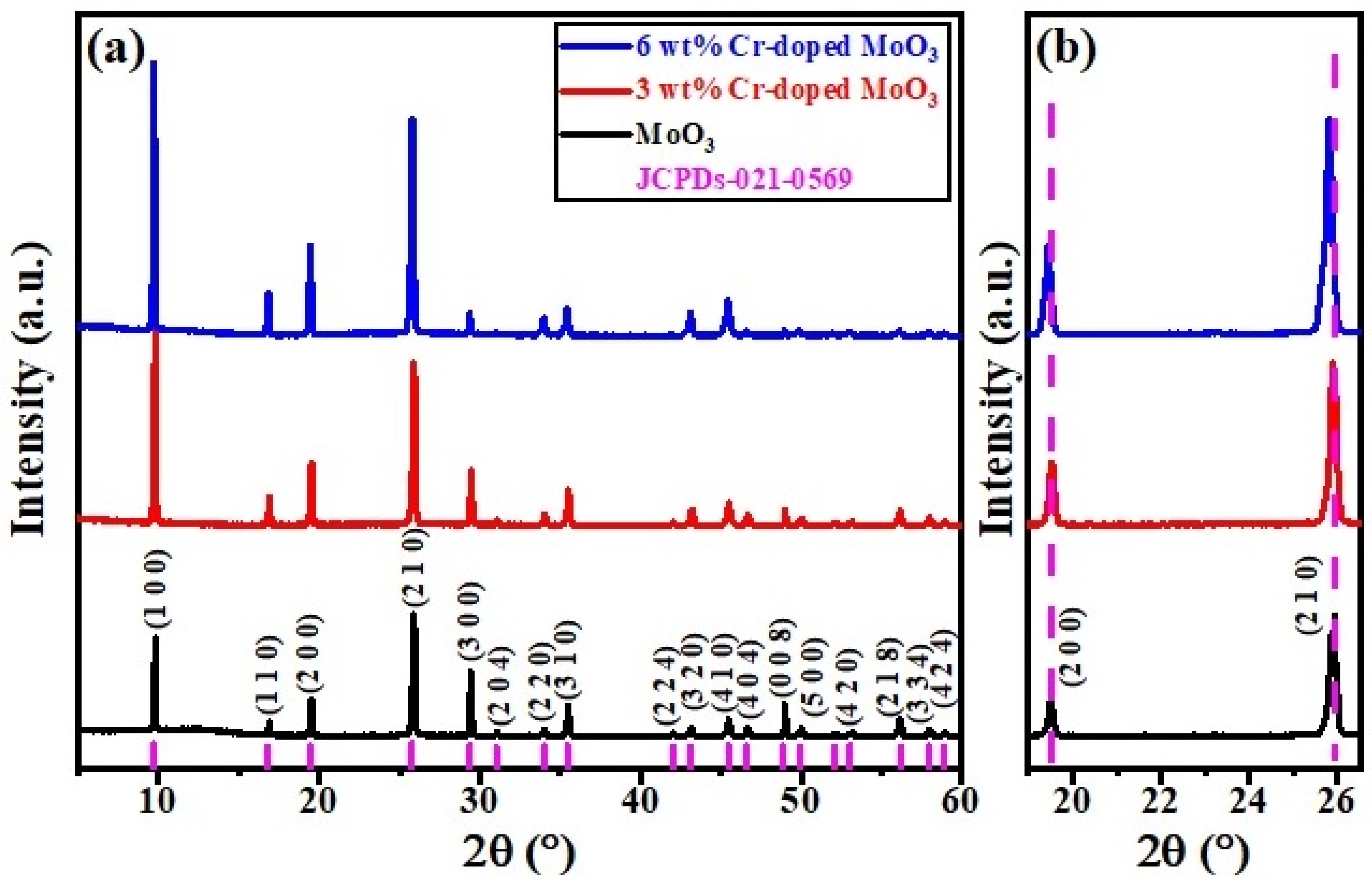
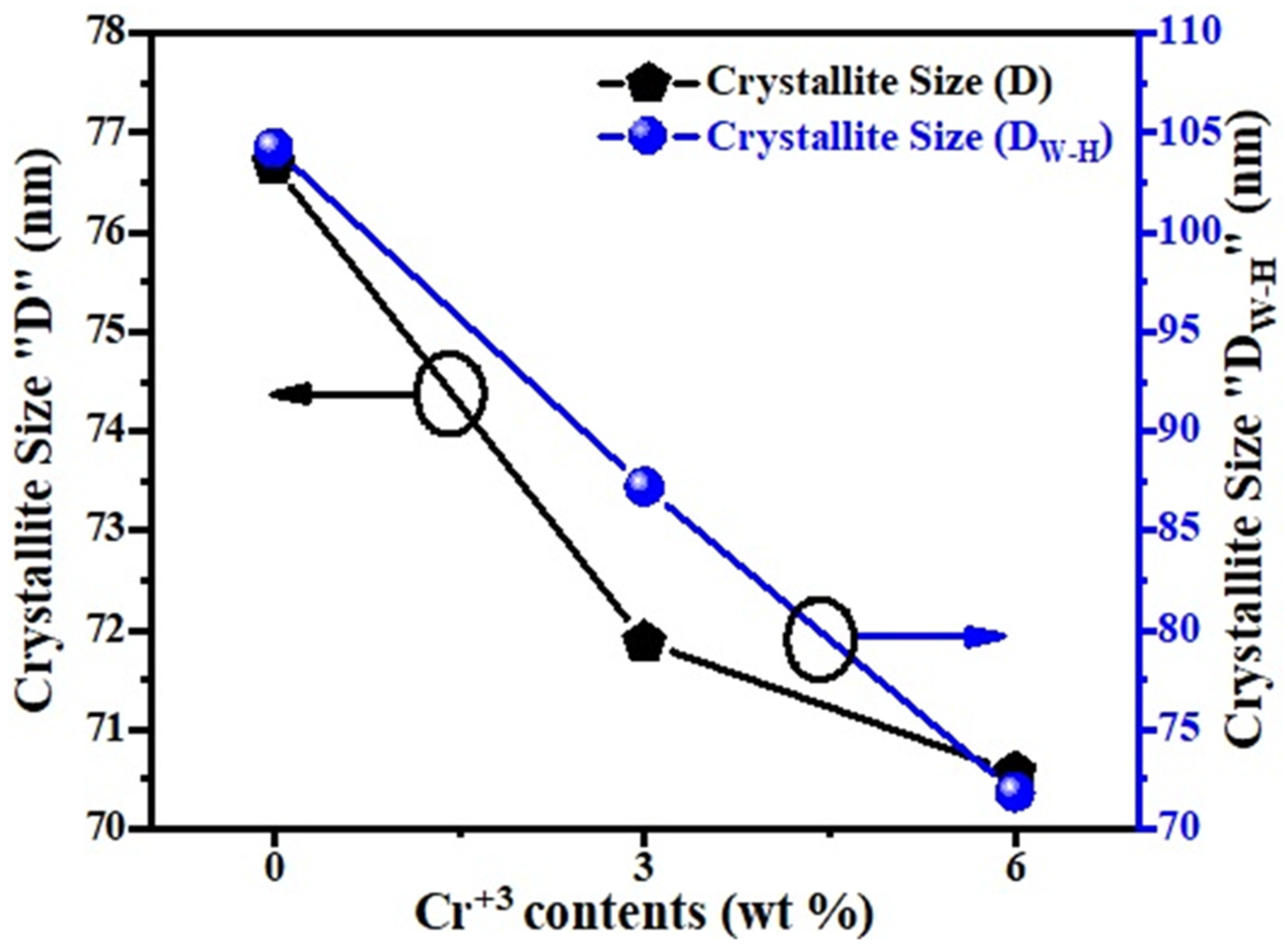

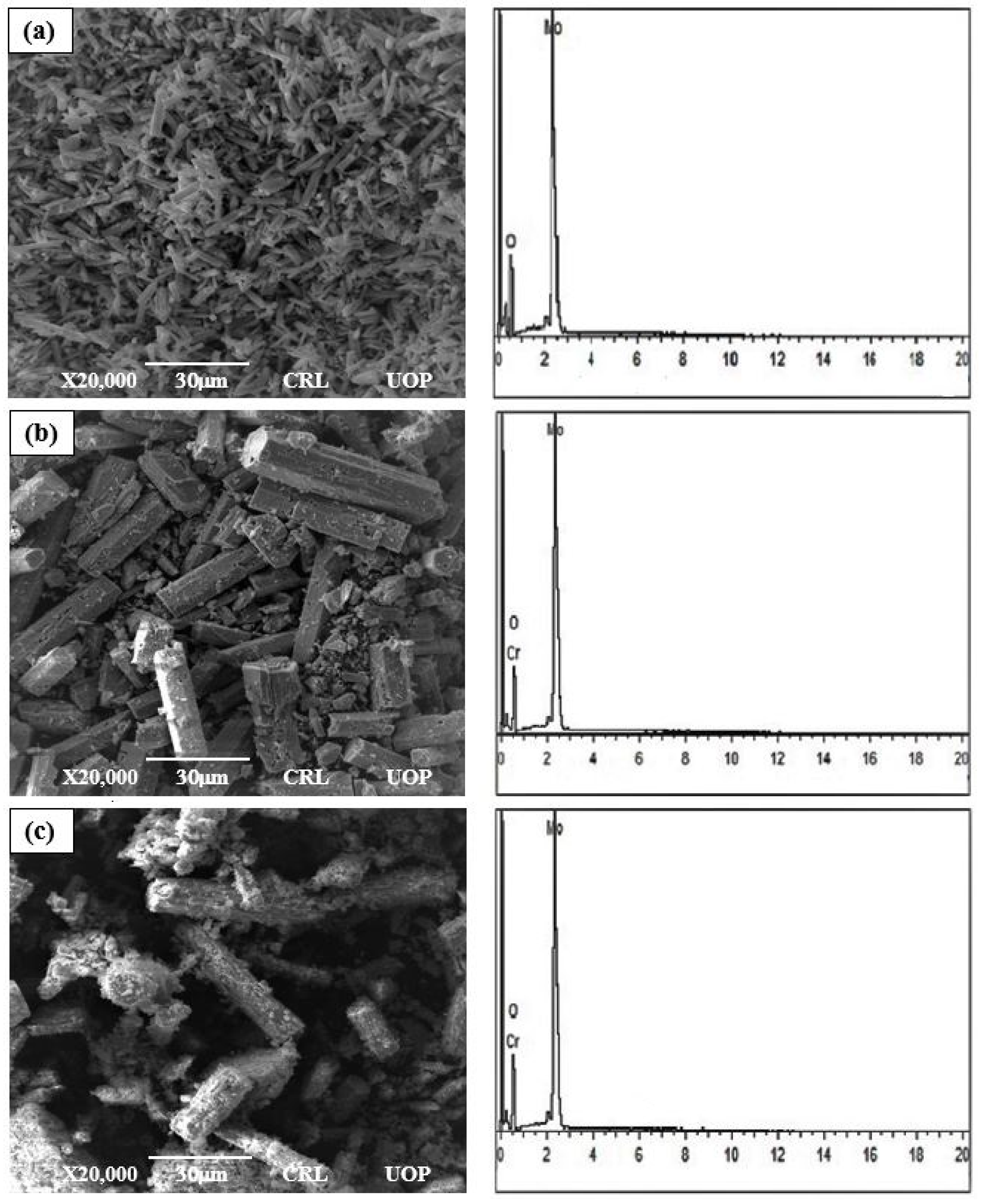
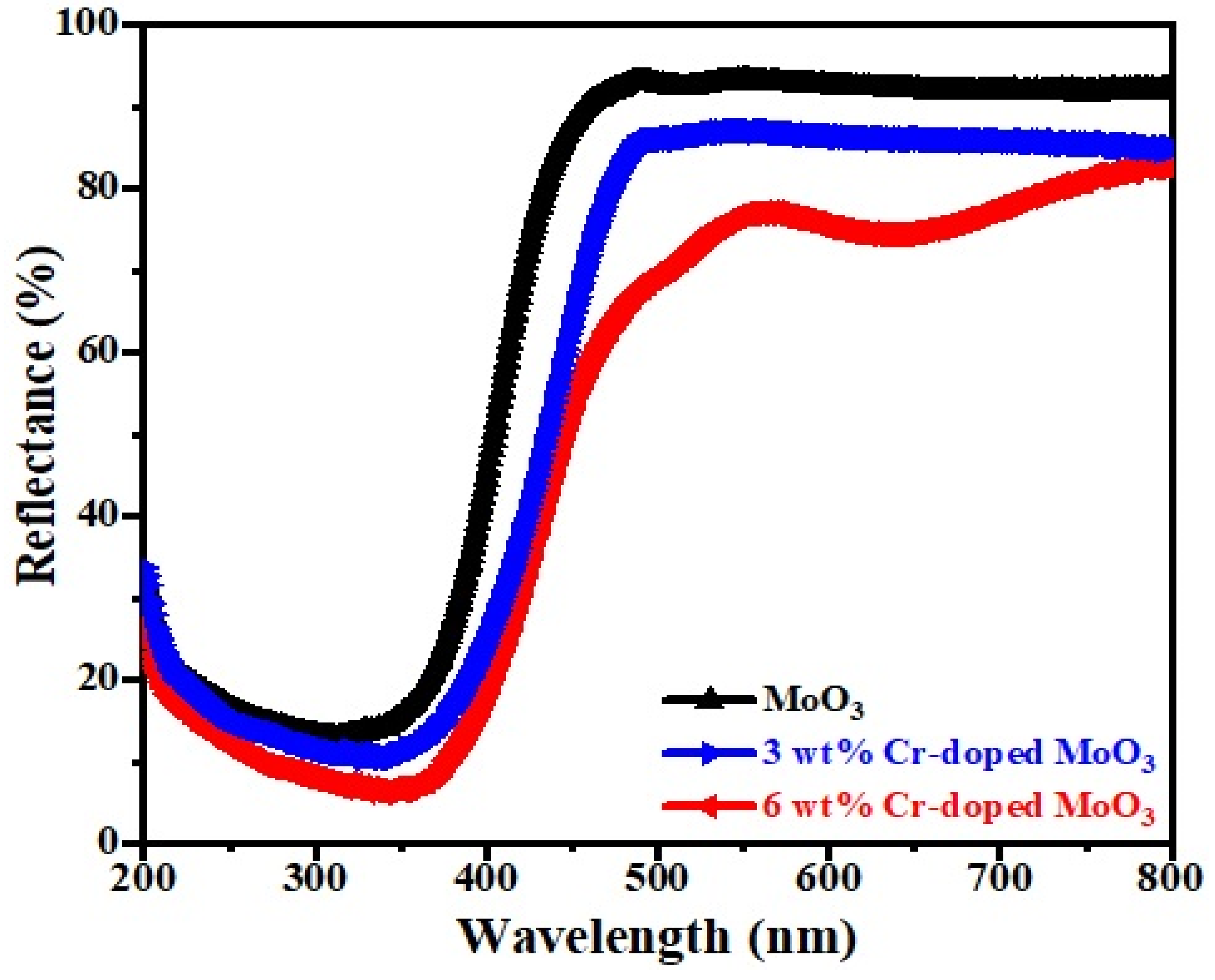
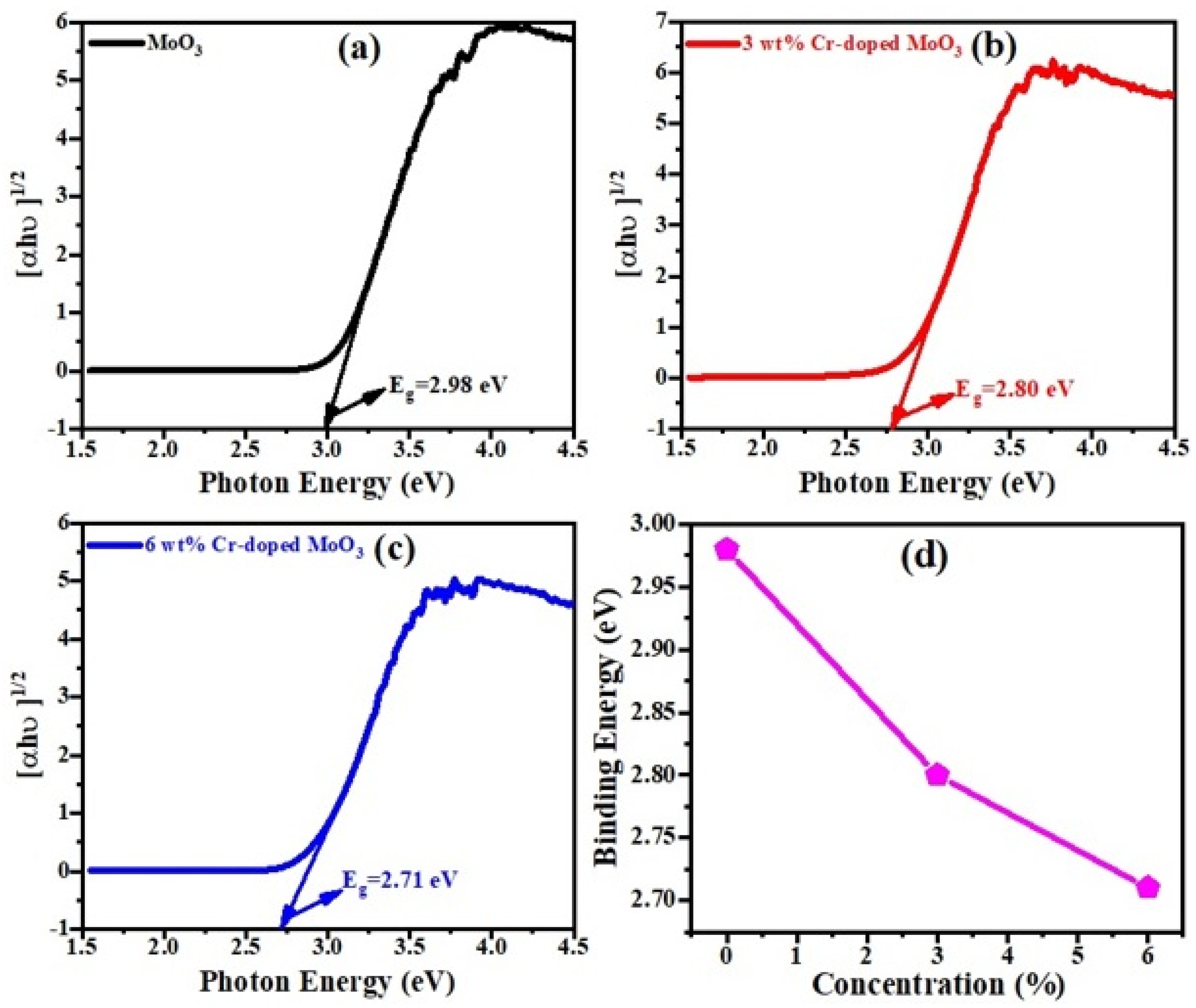
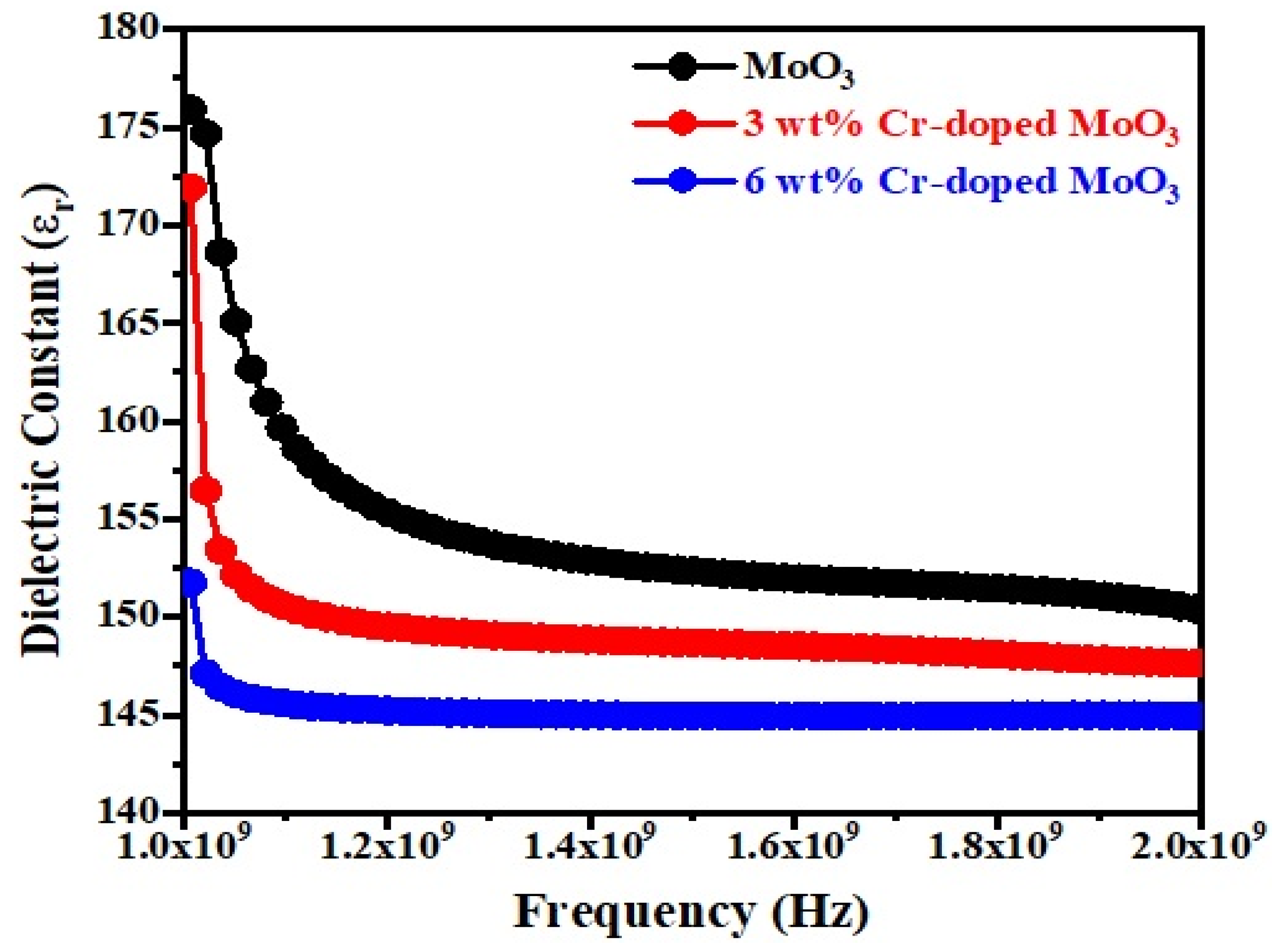

| Composition | Average Crystalline Size (DW–H) | Uncertainty in Average Crystallite Size (DW–H) | Average Micro-Strain (εW–H) | Uncertainty in Average Micro-Strain (εW–H) |
|---|---|---|---|---|
| MoO3 | 104.251 nm | ±0.158 | 5.828 | ±0.462 |
| 3 wt% Cr-doped MoO3 | 87.204 nm | ±0.006 | 2.255 | ±0.391 |
| 6 wt% Cr-doped MoO3 | 71.842 nm | ±0.222 | 1.308 | ±1.392 |
| Elements | Atom % (MoO3) | Atom % (MoO3–3%Cr) | Atom % (MoO3–6%Cr) | Weight % (MoO3) | Weight % (MoO3–3%Cr) | Weight % (MoO3–6%Cr) |
|---|---|---|---|---|---|---|
| Molybdenum | 66.66 | 65.25 | 63.83 | 53.77 | 52.96 | 52.12 |
| Chromium | -- | 1.10 | 2.21 | -- | 1.52 | 3.10 |
| Oxygen | 33.34 | 33.65 | 33.96 | 46.23 | 45.52 | 44.78 |
| Total | 100 | 100 | 100 | 100 | 100 | 100 |
| Composition | a = b (Å) | c (Å) | D (nm) | Eg (eV) |
|---|---|---|---|---|
| MoO3 | 10.53 | 14.88 | 76.69 | 2.98 |
| 3% Cr-doped MoO3 | 10.54 | 14.88 | 71.88 | 2.80 |
| 6% Cr-doped MoO3 | 10.55 | 14.89 | 70.57 | 2.71 |
Publisher’s Note: MDPI stays neutral with regard to jurisdictional claims in published maps and institutional affiliations. |
© 2022 by the authors. Licensee MDPI, Basel, Switzerland. This article is an open access article distributed under the terms and conditions of the Creative Commons Attribution (CC BY) license (https://creativecommons.org/licenses/by/4.0/).
Share and Cite
Zaman, A.; Shukla, N.K.; Ali, A.; Alhodaib, A.; Tirth, V.; Kareem, Z.H.; Jabbar, A.H.; Mushtaq, M.; Abbas, M.; AlHarbi, M.; et al. Effect of Cr Doping on the Structural, Optical and Dielectric Properties of MoO3 Microrods Synthesized by Sol-Gel Auto Combustion Method. Crystals 2022, 12, 1259. https://doi.org/10.3390/cryst12091259
Zaman A, Shukla NK, Ali A, Alhodaib A, Tirth V, Kareem ZH, Jabbar AH, Mushtaq M, Abbas M, AlHarbi M, et al. Effect of Cr Doping on the Structural, Optical and Dielectric Properties of MoO3 Microrods Synthesized by Sol-Gel Auto Combustion Method. Crystals. 2022; 12(9):1259. https://doi.org/10.3390/cryst12091259
Chicago/Turabian StyleZaman, Abid, Neeraj Kumar Shukla, Asad Ali, Aiyeshah Alhodaib, Vineet Tirth, Zahraa Hashim Kareem, Abdullah Hasan Jabbar, Muhammad Mushtaq, Mujahid Abbas, Mona AlHarbi, and et al. 2022. "Effect of Cr Doping on the Structural, Optical and Dielectric Properties of MoO3 Microrods Synthesized by Sol-Gel Auto Combustion Method" Crystals 12, no. 9: 1259. https://doi.org/10.3390/cryst12091259
APA StyleZaman, A., Shukla, N. K., Ali, A., Alhodaib, A., Tirth, V., Kareem, Z. H., Jabbar, A. H., Mushtaq, M., Abbas, M., AlHarbi, M., & Aljohani, M. (2022). Effect of Cr Doping on the Structural, Optical and Dielectric Properties of MoO3 Microrods Synthesized by Sol-Gel Auto Combustion Method. Crystals, 12(9), 1259. https://doi.org/10.3390/cryst12091259






